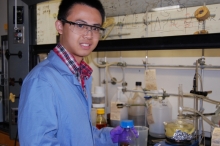
University:
Major:
Mentor(s):
Faculty Sponsor(s):
Faculty Sponsor's Department:
Project Title:
Project Description:
Photocatalytic reactions have attracted a lot of attention for their promising potential for converting solar energy and for cleaning pollutants. Among photocatalysts, semiconductors are the most popular materials, and the metal-semiconductor (M-S) junction is widely used to improve their efficiency. However, M-S junction can either be an Ohmic contact or a Schottky barrier, depending on the material’s Fermi level. Herein, we design the M-S core@shell nanoparticle model with the same nanoparticle structure to fabricate different serials of M-S contacts, and study the exact influence of M-S contact types on photocatalytic activities systematically for the first time. We have successfully synthesized Cu2O coated nanoparticles with expected structure (Au@Cu2O, Au@Pt@Cu2O, Au@Pd@Cu2O and Au@Ag@Cu2O). Their photocatalytic activities have been tested in solutions via monitoring the photoreductionrate of methylene blue. Among these systems, the photoreduction rates in Au@Cu2O, Au@Pt@Cu2O and Au@Pd@Cu2O solutions are similar, whereas the photoreduction rate in Au@Ag@Cu2O solution is only half of them. Because the work functions of Au, Pt and Pd are higher than that of Cu2O, there is an Ohmic Contact between Au-Cu2O, Pt-Cu2O and Pd-Cu2O; while the work function of Ag is lower than that of Cu2O, thus a Schottky Barrier is on the interface of Ag-Cu2O, which retards the reaction. Therefore, our results reveal a direct correlation between the M-S interface and the rate of photocatalytic reaction. This means a rational designed combination of metal and semiconductor is essential for the photocatalytic performance.
